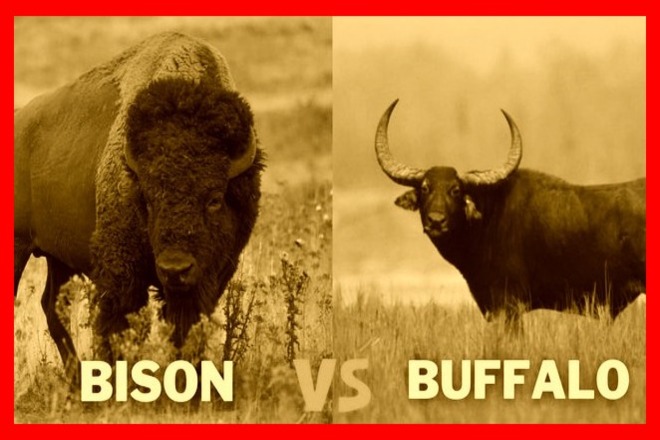Bison and Buffalo
When it comes to large, hairy animals with horns, the terms “bison” and “buffalo” are often used interchangeably; however, these two species have several distinct differences. While buffalo roam the African grasslands, bison inhabit North American and European forests. Regarding behavior and lifestyle, buffalo typically travel together in large herds for safety and protection from predators; bison also form flocks, but much smaller ones comprised of only a dozen or so individuals. While buffalos are primarily grazers that feed off grasses and shrubbery, bison have been observed consuming tree bark and other woody materials during winter months when food sources become scarce. For wildlife enthusiasts or those simply curious about these majestic creatures, there is much more that distinguishes bison from buffalo beyond their size.
What is the Difference Between Bison and Buffalo?
When it comes to large, hairy animals with horns, it’s easy to confuse bison and buffalo. First, however, it’s essential to understand that these words refer to two distinct animal species. While they may appear similar, bison are native to North America, while buffalo are found in Africa and Asia. So if you’re in the United States and come across a large, hairy animal with horns, it’s almost certainly a bison.
But why is it important to know the difference between these two species? For starters, it helps us better understand the world around us and the diverse range of animal species. Additionally, there are specific cultural and historical implications associated with each animal. For example, the buffalo has long been a symbol of the American West and played a significant role in the lives of many Native American tribes. But on the other hand, the bison has been an essential part of North American ecosystems for thousands of years and has played a crucial role in maintaining the balance of these ecosystems.
So the next time you’re out in the wilderness and come across a large, hairy animal with horns, take a moment to appreciate the unique characteristics that make it either a bison or a buffalo. Not only will you expand your knowledge of the natural world, but you’ll also gain a deeper appreciation for the beauty and diversity of the animal kingdom.
Bison Vs. Buffalo: What’s The Difference?
Bison tend to have larger heads and humps than buffalo and shorter, curvier horns. They also have shaggy, brown fur and a beard, while buffalo have sleeker black or brown hair and no beard. Behavior: Bison are known for their “herd mentality” and often travel in large groups. They are also more aggressive than buffalo, especially during mating season. Location: As mentioned earlier, bison are native to North America, while buffalo are found in Africa and Asia.
You Say Buffalo; I Say Bison: What’s the Difference?
One of the most prevalent misconceptions about bison and buffalo is their similarity because their names sound alike. In truth, these animals have many physical and behavioral dissimilarities that set them apart. The different dietary habits of bison and buffalo are of particular importance – bison graze mainly on grasses found in open prairies and grasslands. In contrast, buffalo tend to forage in a broader array of vegetation that may include shrubs found in more wooded environments. Furthermore, various behavioral differences between the two species may cause further confusion when differentiating them. Bison, for example, are far less resistant to domestication than buffalo and have an aggressive disposition. Both bison and buffalo are iconic American species with crucial historical significance; however, it is essential to remember their intrinsic differences so as not to conflate them.
What is the Main Idea of Bison or Buffalo?
At their core, bison and buffalo are two distinct species of large, herbivorous mammals with shaggy coats, stocky builds, and impressive horns. Though their superficial similarity in appearance can be confusing to novices, there are significant distinctions between them. Bison, or American buffalo, are typically dark brown with greyish-black muzzles covered in fur. They possess relatively short heads and curved horns with sharp edges that curve outwards from the sides of their head. Unlike bison, water buffalo have more significant and rounder head with smoother horns that curl upwards from the sides of the head. They can range in color from black to light grey or yellowish-white, depending on the specific subspecies.
Regarding behavior, bison tend to be more active, while buffalo tend to be less so. Bison live in herds and roam long distances throughout their day in search of new pastureland, while buffalo prefer still waters and often graze alone or in small family groups. Bison also engage more actively in social behaviors, such as wallowing and rubbing up against trees or rocks for grooming, while buffalo generally do not partake in these activities. Diet is another area of contrast as b
What is the Difference Between a Buffalo and a Bison?
As the critical distinction between buffalo and bison is their geographic distribution, the most apparent difference between these two species is where they can be found. Bison are endemic to North America, from Canada in the north down to Mexico in the south, and predominantly dwell on open prairies, mountain meadows, and even deserts. Conversely, buffalo can be found mainly in Africa, ranging from northern regions like Ethiopia to more tropical areas such as South Africa. The species also inhabit some parts of Asia, such as India and Nepal, where they share much of their habitat with other large herbivores like elephants and rhinoceroses.
Regarding physical characteristics, the two animals can be challenging to tell apart. However, subtle features allow them to be differentiated: bison are slightly taller than buffalo with longer horns that curve back away from their heads; bison tend to have a shaggier coat than buffalo due to their thicker fur covering. Moreover, while both species possess formidable strength in territorial fights and defensive maneuvers against predators, buffalo are known for being more aggressive than their bovid counterparts. In summary, there is an array of differences between buffalo and bison.
Why Do People Confuse Bison with Buffalo?
People often mistakenly interchange the terms “bison” and “buffalo” due to several factors. Chiefly, their phonetic similarity contributes to the confusion, as many people are prone to associate the two words due to their aural similarity. Additionally, both animals have large, hairy bodies and horns that appear similar at first glance. Furthermore, there is an aspect of historical precedence behind this mistake; during the early European settlement in North America, bison were mislabeled as buffalo because they resembled the water buffalo seen in Africa and Asia. This semantic misunderstanding eventually became embedded within language usage and has continued through the present day. Therefore, while it’s easy to be misled when these terms are used interchangeably, it is essential to note that bison and buffalo belong to two distinct species with unique characteristics.
Which is Bigger: Bison or Buffalo?
Bison and buffalo are both impressive bovids, but they can differ significantly in size. Generally speaking, bison tend to be larger than buffalo, although this varies depending on the species. The American bison (the most common type of bison in North America) typically weighs up to 2,000 pounds (910 KG), whereas the water buffalo (found in Asia) can weigh up to 2,600 pounds (1200 KG). Compared to other species, bison are more likely to be larger and more imposing than buffalo. Nevertheless, size is not always a reliable indicator of strength; regardless of their respective sizes, both types of animals possess formidable strength and power.
Conclusion
Although “bison” and “buffalo” may be used interchangeably, their relationship depends on their region of origin. Bison are large, hoofed animals typically found in North America and Europe, while buffalo can refer to any of the four large African species or water buffalo in Asia. In addition to their geographic distinction, bison and buffalo differ significantly in appearance. Bison often have a light tan or brown coat with a pronounced hump over their shoulders, shaggy fur on their head and forequarters, and a massive set of horns. On the other hand, buffalo possess an unmistakable cape that extends from the strong muscles along their neck to cover much of their back and flanks – combined with its stocky body shape and short horns, this feature helps distinguish buffalo from other species.
Despite appearances, there is far more complexity surrounding bison and buffalo than initially assumed. Although they share similarities in size and behavior – like grazing on grasses – these creatures have unique evolutionary significance within distinct ecosystems. For example, bison played an integral role in maintaining prairies throughout. In addition, North American bison have long been admired for their ability to shape and influence the landscape with their migratory patterns. Their movements, which occur during the summer and winter, are the primary cause of vegetation changes in the areas they travel through. African buffalo herds play an equally important role in managing their environment; by grazing on trees and limiting their growth, these animals can balance grasses and trees and create an environment conducive to plant and animal life. By observing and studying the behavior of these herds, we can gain valuable insights into how to protect our territories.



















